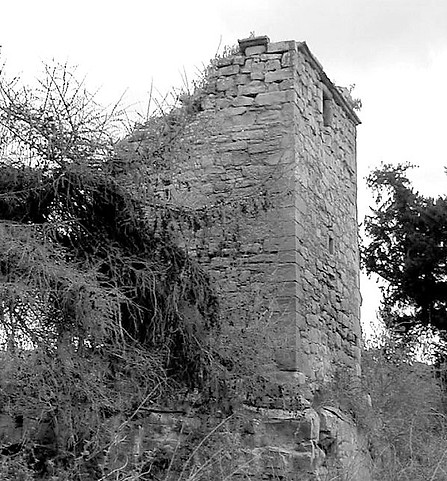Blanerne

Blanerne House or Lumsden Castle in Berwickshire
The present Mansion was built in 1897 after a fire destroyed the previous house. The Lumsdaines and Sandys-Lumsdaines lived on this site from the 1320s until 1920.
The castle was the historical seat of the Lumsdaine family for over four centuries. The surviving remains are dated to the 16th century, although the site may have been occupied as far back as the 12th century.
Little remains of the Southern stronghold of the Lumsdens, Blanerne Castle, on the banks of the Whiteadder in Berwickshire, save one of the flanking towers. Nearby stands the fine Manor house of Blanerne, rebuilt in 1895 after a disastrous fire. Sadly it was sold by the Lumsdaines in 1929.
Blanerne Peel
Blanerne Castle is the remains of a 16th-century fortified house, located in the grounds of Blanerne House, an 18th-century country house between Chirnside and Preston in the Scottish Borders. It was the home of the Lumsdaines in the 14th and 15th centuries.The house and castle sit on the north bank of the Whiteadder Water, around 6 kilometres (3.7 mi) north-east of Duns. The house is currently operated as a guest house, offering access to fishing and game shooting. Both the house and castle are category B listed buildings and the castle is further protected as a Scheduled Ancient Monument.

Wikipedia
Blanerne Castle is the remains of a 16th-century fortified house, located in the grounds of Blanerne House, an 18th-century country house between Chirnside and Preston in the Scottish Borders. The house and castle sit on the north bank of the Whiteadder Water, around 6 kilometres (3.7 mi) north-east of Duns.
The castle was the historical seat of the Lumsdaine family for over four centuries. The surviving remains are dated to the 16th century, although the site may have been occupied as far back as the 12th century. The remains include a keep or kitchen block, with a detached guard house to the west.[1] The castle is protected as a Scheduled Ancient Monument.[2]
A popular Berwickshire rhyme refers to the medieval strengths of Blanerne and the nearby fortresses of Billie Castle, and Bonkyll Castle referring to their construction in the time of David I and their destruction following the Rough wooing:
Bunkle, Billie and Blanerne
Three castles strong as airn
Built when Davie was a Bairn
Theyll all gang doon,
Wi Scotland's Croon
An ilka ane shall be a cairn
Blanerne House was constructed in the 18th century. Around 1830, plans for the house were prepared by the architect William Burn, although these may not have been carried out. A major fire in 1895 led to the rebuilding in 1897 of the house in its present form. It is currently operated as a guest house, offering access to fishing and game shooting.
The house is a category B listed building[3]
Blanerne House is a delightful country manor in Scottish Borders that was the historical seat of the Lumsdaine family for over four centuries.
Sitting on the banks of the Whiteadder River, a tributary to the River Tweed, there is 560 yards of double-bank river frontage with fishing for salmon, sea trout and brown trout on the estate.
The estate also has connections with local game shoots with a stock of grouse, pheasants, ducks, pigeons and other game available dependent on the season.

The recently converted apartment sleeps up to six people and is fully self-contained, with three bedrooms, its own kitchen, shower and bathroom, and lounge.
A variety of local attractions include golf, horse racing, horse riding and cross country trekking, cycling, surfing, diving, whisky tasting and walking.
Bookings can be made by contacting
Anne and Neil by telephone (01890 817156)
The other castles mentioned are Bunkle Castle and Billie Castle, and the Davy mentioned is David I, which suggests that all three castles were in existence by the late 11th century.
Blanerne was owned by the Blanerne family until it passed by marriage to the Lumsdens in 1329.
Blanerne Castle was destroyed by the Earl of Hertford during the Rough Wooing in 1544, and is now a ruin.
Towards the end of the 16th century James Lumsden, son of John Lumsden of Blanerne, married the heiress of the lands of Airdrie, presumably also a Lumsden, and from them descended the Lumsdens of Innergellie, Airdrie, Strathvithie and Mountquhannie.
It is marked on Moll’s mid-18th century map as Blaneirn, seemingly as an empty fenced plot. In December 1864 the Lumsdaine heiress, Mary Lilias Lumsdaine, sister of William Lumsdaine of Rennyhill, died and was succeeded by her son, the Reverend Francis Gordon Sandys-Lumsdaine, in Lumsdaine, Blanerne and Innergellie.
http://www.stravaiging.com/history/castle/blanerne-castle/


